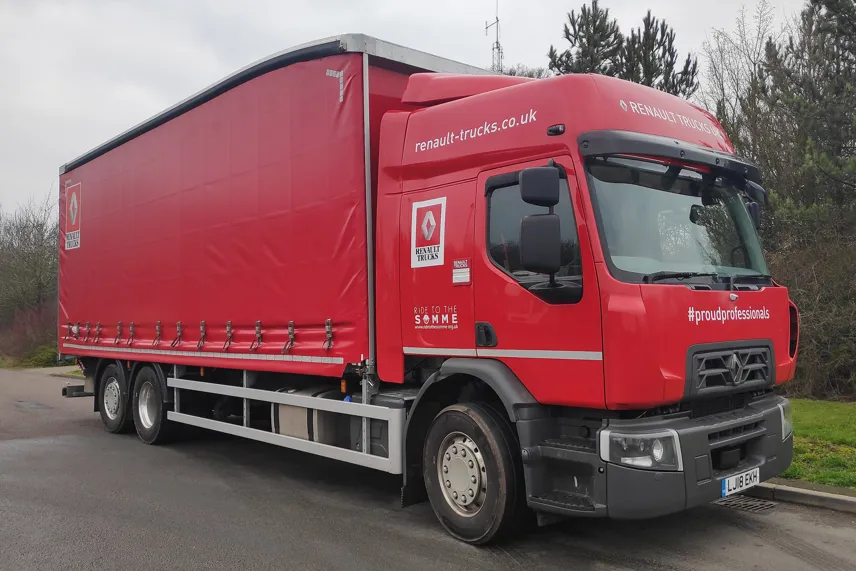Review
Renault Trucks has been making great strides in recent years into the heavy truck tractor unit market with its T range which has attracted a number of loyal followers and possibly reflects the recent main focus of the manufacturer.
Of course, there’s more to the UK truck market than tractor units and perhaps the distribution sector has been under-represented. Although there’s no reason why, given it offers a full range of product under the D banner.
With this in mind, we thought it worthwhile to look at one of the unsung heroes of its product line-up, the three axle 6x2.
As many know, Renault Trucks shares its engine line-up with parent company Volvo Trucks. Consequently the DTi8 7.7 litre Euro VI engine can also be found in Volvo trucks such as the FE. Power ratings for the engine start at 253PS with 950 Nm, followed by the 284PS with 1050Nm and finally the top of the D8 power range the 324PS and 1200Nm.
The three-axle models feature the latter engine which is certainly the most suitable for a vehicle rated at 26 tonnes. The six-cylinder in-line diesel engine has four valves per cylinder and a common rail high-pressure direct fuel-injection working at 2,000 bar.
The engine also features Renault’s Optibrake system which is a combination of exhaust brake and valve compression braking which via an electronic management system develops 231PS coupled to the service brake.
Behind the 7.7 litre engine is a single-plate 430mm diameter clutch matched to an AT 2412F Optidriver automated gearbox with 12 forward gears.
Within the D range there is more than 100 variants so it no surprise the 26 tonne gross vehicle weight (GVW) features 13 wheelbases starting at 3.25m to 6.5m measured between axle one and axle two.
As far as axle suspension is concerned, the front steered features a standard leaf spring with the second a single reduction drive axle while the third single wheel axle is steered as well as liftable via an airbag.
The front axle is plated at eight tonnes and the second rated at 11.5 tonnes. Just behind is the third steered single wheel lift axle rated at 7.5 tonnes.
As mentioned, there’s an effective engine brake system already on the D26 but the safety features do not stop there.
The electronic braking systems consists of the normal suspects such as anti-lock braking system (ABS), anti-slip regulation (ASR), electronic stability control (ESC), trajectory control and anti-rollover system, emergency brake assist (EBA), emergency brake lights (EBL) and Hill Hold. There’s also the option of drag torque control which controls the amount of torque input during downshifting.
While the D range has, in theory, a 2.1m and 2.3m cab, as far as the three axle models are concerned, only the latter is available although it does have four cab configurations – Day, Global, Night & Day and Sleeper.
The hydraulically tiltable steel cab has a standard mechanical four-point suspension with the option of air suspension with a ride-height control system.
As well as the normal heated remote-control rear view mirrors, there is a practical and great safety feature – the passenger vision door with deep glazed window at the bottom of the door.
Inside the cab is a group of upper storage cupboards, two storage compartments with lids, a sliding side sun screen on the driver’s side and a television shelf with 24V provision and four fixing rings. Ambient lighting gives the cab a nice quality feel and there are a series of spotlights along the cab roof.
The infotainment system features an analogue and digital radio with audio playback via USB and streaming via Bluetooth 4.0 with hands-free function and steering wheel-mounted controls.
The cab is a not flat floor and therefore has a pronounced raised engine tunnel which is handy for placing items such as delivery sheets etc. It also houses the park brake.
Renault Trucks’ distribution range could be considered a real unsung hero of its type. This three-axle variant has a lot to commend it and while the market for three-axle, rear steered rigids is not as great as the tractor unit sector, a few more on UK roads would not be a bad thing. Opening the wide driver’s door reveals just a couple of steps leading to the cab floor and as you sit down there’s an air-suspended “ Comfort” driver’s seat complete with lumbar support, heated cushion and seatback, seat depth adjustment and armrest, even the seat belts are red! As I look across the engine “hump” I also notice the passenger seat is air suspended as well.
In front of me, in a semi-wrap round style is the central instrument panel flanked by a couple of rows of switches and the single DIN infotainment system. Which could be made to look better integrated into the dash, as it looks a little like an after thought. Just a little further to left of that are the rotatory dials for the heating and ventilation system.
Perhaps the biggest surprise are the number of stalks and controls protruding from the steering wheel, they cover standard features such as indicators, windscreen wipers etc but also cruise control, infotainment system, the three stage engine brake and finally the functions of the automated gearbox.
On the road, cab visibility is certainly aided by the low vision window on the passenger side, although the Brigade all round cameras did make it redundant and I would not spec an urban truck without it.
Driving along, the rev counter has a green band ranging from 1000 to 1700 rpm and most gear changes ensure you don’t go outside this area, although a heavy kickdown can override this. Even on kickdown the engine noise is not too intrusive considering you are sitting right by the side of it!!
Steering is positive and the turning circle is obviously helped by the rear steer axle and chassis suspension handles the eight without any drama.
















